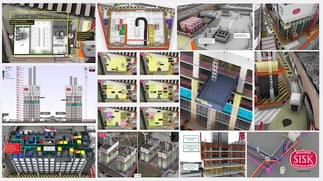 Sisk has used SYNCHRO 4D on more than 100 projects. Image source: Sisk. Click image to enlarge.
Sisk has used SYNCHRO 4D on more than 100 projects. Image source: Sisk. Click image to enlarge.
The use of 4D technology on construction projects has progressed from novelty to necessity for many construction contractors, as firms find new ways to put digital delivery to use. Put simply, digital delivery means using digital models, information, and supporting tools to help complete a project. For construction firms, it means using 3D models and data contained in a digital twin for a paperless, streamlined process, enabling collaboration across the supply chain.
Instead of just providing a means to impress clients and colleagues with video simulations, 4D is playing key roles in planning and executing projects, maintaining a key presence throughout all project stages as part of a digital delivery approach.
While early use of 4D—adding the element of time to 3D models—primarily gained attention for generating construction animations and schedule information, more recent applications are providing value on a day-to-day basis. From pre-bid through final construction and closeout, construction teams are using 4D to work more efficiently, saving time and money and avoiding field problems along the way.
By leveraging collaborative modeling and construction simulation software, teams can take advantage of visual planning. This allows teams to track projects in a single visual to identify issues and what-if scenarios early in a digital environment, reducing project risks, delays, and time-consuming rework.
“It’s now part of the planning process. It’s not just an output,” said Josh Hanson, Head of Digital Project Delivery with John Sisk & Son Ltd., an international construction and civil engineering company, with operations in Ireland, the U.K. and mainland Europe.
Since investing in 4D, Sisk has seen an increase in program performance, with more than 80% of projects using this technology reporting “on program” against their original baselines. Image source: Sisk. Click image to enlarge.
Sisk has used SYNCHRO 4D from Bentley Systems on more than 100 projects for various forms of planning, scheduling, and project management, according to Liam Clarke, Regional 4D Planning Manager in the northern U.K. “It might be anything from early advice all the way through full construction sequencing,” Clarke noted. “The pre-construction end tends to be our most intense period. It’s the optimal time to really get the value of a digital rehearsal. There’s still flexibility in what you can do and things you can change.”
In addition to reviewing various construction-staging scenarios during pre-construction, Sisk maintains tight links with design models during construction, incorporating temporary works, managing field changes, and keeping the 4D model up to date, noted Hanson. “It’s the process we go through in terms of linking models to the program and seeing the impact [of changes].”
Watch excerpts from the Cadalyst interview with Hanson and Clarke, from Sisk & Son here:
Stadium Project Benefits
Laing O’Rourke, a U.K.-based engineering and construction company, is also expanding its use of 4D technology. “In the past, you’d get a sequence and a video to show how a project was going to be built […] and then, ultimately, you would never use it again,” said Simon Beards, Principal Planner for Laing O'Rourke. “It’s become a day-to-day tool now,” he added.
On the Everton FC Stadium project in Liverpool, Laing O’Rourke has relied heavily on SYNCHRO to plan, sequence, and track progress on the project. The 52,888-seat stadium features four covered seating areas, with the structural frame consisting primarily of steel trusses and precast concrete. Consequently, the project is highly dependent on cranes to lift and place heavy components.
Beards said SYNCHRO has helped the team plan crane operations to avoid clashes, as well as identify when and where cranes are needed, avoiding costly idle time. “It can cost tens of thousands of pounds if cranes are stored for the day,” he noted.
Laing O’Rourke used SYNCHRO 4D to plan, sequence, and track progress on the Everton FC Stadium. Image source: Laing O’Rourke. Click image to enlarge.
As lead contractor on the Everton project, Laing O’Rourke has also used SYNCHRO in conjunction with drone footage to track progress. “We track the stages and then review it against the 4D model, and it’s really quite accurate,” Beards said. “Generally once a week, we’ll mark up the progress, update the 4D plan, and then the team has got access to the up-to-date plan and the forecast going forward.”
SYNCHRO 4D was used along with drone imagery to generate weekly updates on the Everton FC Stadium. Image source: Laing O’Rourke. Click image to enlarge.
Gaining Buy-in
Through regular updates and other timely information generated by 4D applications, Beards has seen growing acceptance of the technology on the Everton project, as well as others. “The real win is where it engaged the team so that they were able to buy into it. Rather than the program only being on the planner’s laptop or desktop, it would be shared amongst the whole team. It was visible, so they could interact with the program and ultimately add value to the project.”
To enable more collaboration, Laing O’Rourke built an immersion room, where models can be projected onto walls for interactive reviews. “Rather than sit around the desk and chat through things and sometimes lose engagement, we have an interactive space where people get up and walk around and point [to the model],” Beards said. The system includes four projectors — one for each wall — and sensors to track participants’ motions. “We’ll spin through the weeks and people look at things and understand what they want to do.”
Watch excerpts from the Cadalyst interview with Beards from Laing O'Rourke here:
While benefits are difficult to quantify, both Sisk and Laing O’Rourke believe 4D applications are saving money in the long run. Sisk recently compiled data on 22 projects for the previous year and estimated GBP 25-million in cost avoidance related to potential field issues identified before they occurred, according to Hanson. “We call them issues, but we also like to say that there could be opportunities. We’re not only looking for the problem; we’re looking for where there’s a chance to do things a bit better or differently,” he said, “[which provides additional intangible benefits.] We feel that if you get problems out the way at the start, you have a better product on site.”
Since making the investment in 4D, Sisk has also seen an increase in program performance, with more than 80% of projects using this technology reporting “on program” against their original baselines, according to Hanson. “We have a strong vision for how we will continue to further democratize this form of technology to ensure that all stakeholders to a project are digitally enabled to maximise the value it brings,” he said.
Laing O’Rourke built an immersion room to enable collaboration of construction team members. Image source: Laing O’Rourke. Click image to enlarge.
Applying Lessons Learned
When deploying 4D technology on future projects, firms can benefit from reviewing knowledge gained on previous projects, according to Hanson. “If we’re going to be doing something on every project and we’re looking to do it better on every project, we’ve probably got that data stored somewhere,” he said, referring to records identifying common problems and trends.
Clarke also noted that data from previous projects can potentially help the industry improve performance through still-evolving technologies, such as artificial intelligence. “The construction industry is awakening to the amount of data that it holds,” said Clarke. “There’s this huge opportunity there, I think, to vastly improve on historic rates.”
While technology figures to play a key role in leveraging burgeoning amounts of data, Clarke also noted the importance of maintaining the human element. “It’s still about sitting in front of people and going through it,” he said.
Laing O’Rourke’s Beards also noted the importance of human involvement and gaining acceptance of technology from team participants. In an industry not always open to change, he said previous 4D successes can aid the process of adopting the technology. “Now that people are seeing how it’s worked, they’re thinking ‘it must be adding some sort of value.’” Based on the success of the Everton project, he regularly receives inquiries from other company units around the world on how to apply 4D technology.
On future projects, Beards sees benefits in introducing certain 4D applications earlier in the project timeline. In particular, he foresees earlier introduction of elements that allow construction teams to access data in various contexts, such as through maps and CAD data, as well as to handle project updates, inspection data, and requests for information (RFIs).
Linear Projects Also Benefit
SYNCHRO and 4D planning are also proving valuable on digitally delivering linear infrastructure work, such as rail and highway projects. In Melbourne, Australia, where the government of Victoria has been removing dangerous at-grade rail-highway crossings, ACCIONA, a consulting engineering firm, is helping to deliver the Level Crossing Removal Program. ACCIONA, with its alliance partners, was tasked with removing level crossings and constructing new stations along the Frankston Line. One of the additional works packages (AWP2) included removal of level crossings and the upgrade of three stations, with a project cost of AUD 744 million.
The project required meticulous and efficient planning, design, and project delivery—and temporarily shutting down rail lines and stations. ACCIONA used SYNCHRO 4D to create a 4D construction model of the entire project and deliver a digital asset to the client. The application allowed the team to conduct virtual planning ahead of construction, minimize disruptions to the community, and align the team and stakeholders around a single plan.
Using SYNCHRO Control, the ACCIONA team expanded their 4D cloud collaboration to better handle model federation, data collection, and issue tracking. Meanwhile, SYNCHRO Field enabled teams to access the latest project information on mobile devices, straight from the jobsite. With the iTwin Platform, ACCIONA developed a digital twin of the project that they could adjust in real-time, allowing the team to visualize construction workflows and decide how they could reduce construction time. By leveraging SYNCHRO, ACCIONA streamlined construction planning for the project, reducing staging time by 67% and drafting requests by approximately 88%.
“I see SYNCHRO as the staple in construction and in 4D,” said Daniel Easter, Digital Engineering Manager at ACCIONA. “Our challenges—they’ve now been eradicated because of the developments that have gone through into SYNCHRO. That now means that my team can focus on delivering the project rather than trying to make certain software to fit with one another.”
As part of the Southern Program Alliance, ACCIONA provided a digital asset for an AUD 744 million project to remove level crossings and construct new rail stations. Image source: Bentley. Click image to enlarge.
The Road Ahead
As 4D planning for digital delivery plays larger roles at firms such as Sisk, Laing O’Rourke, and ACCIONA, other industry firms are likely to see similar trends. To meet infrastructure demands and establish new revenue streams, construction firms need to transform and expand their business model by providing digital services that go beyond just project handovers. These digital integrators can provide increased value to modernize project delivery processes for better outcomes, including streamlined construction processes, better quality data, and improved communication.
Designers, subcontractors, and owners may also see the imprints of 4D technology in projects of all shapes and sizes. “I think it will just be a given that your engineer on site will be looking at the 4D model before going to work,” said Sisk’s Hanson.
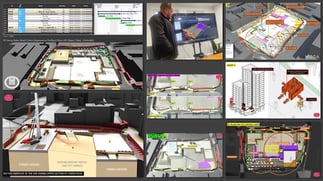
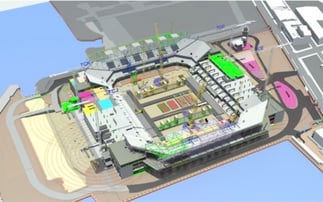
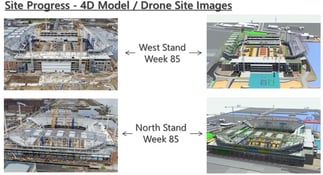
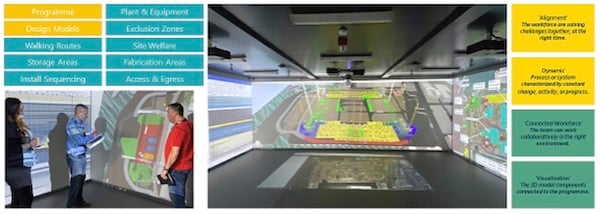
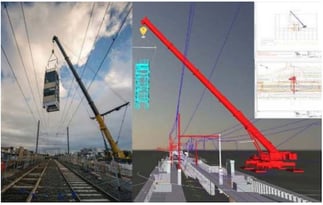


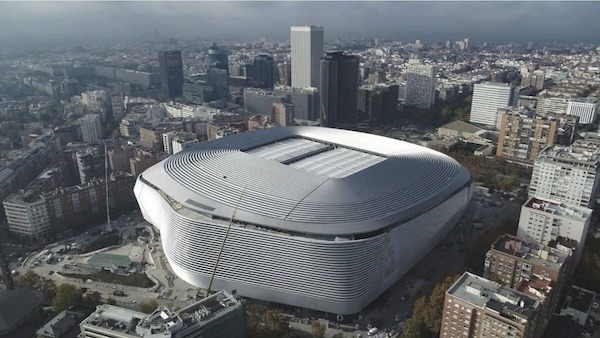


Share This Post